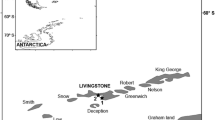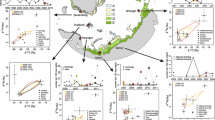Abstract
This study describes the importance of reedbed and riparian habitats for the annual cycle of Cetti’s warbler Cettia cetti. We examined the seasonal variation in population structure and body condition using a long-term data set (11 years) from bird ringing. Because seasonal variations in the differential use of each wetland type should be influenced by food resources and shelter conditions for roosting, a short term study (1 year) was performed to assess the diet, trophic niche and health condition of Cetti’s warbler, and to examine differences in the abundance of food resources and temperature between the two habitats. Results revealed that reedbeds are very important for Cetti’s warbler, supporting large numbers of (mainly) juvenile females during the late summer and autumn periods. Fecal analysis showed that during late summer predator insects (mostly Coleoptera) were more important for Cetti’s warblers on the reedbed, while Phytophagous insects (Hemiptera) were more important for Cetti’s warblers on the riparian habitat. Stable isotope mixing models from blood and feathers samples corroborated these results and revealed the opportunistic foraging behaviour of Cetti’s warbler. The variation on the δ13C values of juvenile secondary feathers was higher for the reedbed, indicating a wider provenance for birds that move into the reedbed in late summer/early autumn. The δ13C values for the riparian area had a smaller variation suggesting that these birds were less dispersive. Overall, the higher abundance of higher trophic level food resources, and higher minimum temperatures for roosting on the reedbed, makes this habitat particularly attractive for Cetti’s warbler after the breeding season.





Similar content being viewed by others
References
Balança G, Schaub M (2005) Post-breeding migration ecology of Reed Acrocephalus scirpaceus. Moustached A. melanopogon And Cetti’s warblers Cettia cetti at a Mediterranean stopover site. Ardea 93:245–257
Barrientos JA (2004) Curso Práctico de Entomología. Asociación spañola de Entomología, CIBIO-Centro Iberoamericano de Biodiversidad & Universitat Autònoma de Barcelona, Barcelona, Spain (in Spanish)
Bearhop S, Waldron S, Votier SC, Furness RW (2002) Factors that influence assimilation rates and fractionation of nitrogen and carbon stable isotopes in avian blood and feathers. Physiol Biochem Zool 75:451–458
Bearhop S, Adams CE, Waldron S, Fuller RA, MacLeod H (2004) Determining trophic niche width: a novel approach using stable isotope analysis. J Anim Ecol 73(5):1007–1012
Bibby CJ (1982) Polygyny and breeding ecology of Cetti’s warbler Cettia cetti. Ibis 124:288–301
Bibby CJ, Green R (1983) Food and fattening of migrating Warblers in some French marshlands. Ringing Migration 4:175–184
Bibby CJ, Lunn J (1982) Conservation of reed beds and their avifauna in England and Wales. Biol Conserv 23:167–186
Bibby CJ, Thomas DK (1984) Sexual dimorphism in size, moult and movements of cetti’ s warbler Cettia cetti. Bird Study 31:28–34
Bolger DT, Scott TA, Rotenberry JT (2001) Use of corridor-like landscape structures by bird and small mammal species. Biol Conserv 102:213–224
Bonham PF, Robertson JCM (1975) The spread of Cetti’s warbler in north-west Europe. British Birds 68:393–408
Brickle NW, Harper DGC (1999) Diet of nestling Corn Buntings Miliaria calandra in southern England examined by compositional analysis of faeces. Bird study 46:319–329
Brown AF, Atkinson PW (1996) Habitat associations of coastal wintering passerines. Bird Study 43:188–200
Burger JC, Patten MA, Rotenberry JT, Redak RA (1999) Foraging ecology of the California gnatcatcher deduced from fecal samples. Oecologia 120:304–310
Caut S, Angulo E, Courchamp F (2009) Variation in discrimination factors (Δ15N and Δ13C): The effect of diet isotopic values and applications for diet reconstruction. J Appl Ecol 46:443–453
Cherel Y, Hobson KA (2005) Stable isotopes, beaks and predators: a new tool to study the trophic ecology of cephalopods, including giant and colossal squids. Proceedings of the Royal Society B-Biological Sciences 272:1601–1607
Cherel Y, Hobson KA, Guinet C, Vanpe C (2007) Stable isotopes document seasonal changes in trophic niches and winter foraging individual specialization in diving predators from the Southern Ocean. Journal of Animal Ecology 76:826–836
Cooper RJ, Whitmore RC (1990) Arthropod sampling methods in ornithology. Avian Biology 13:29–37
Davies NB (1976) Food, Flocking and Territorial Behaviour of the Pied Wagtail (Motacilla alba yarrellii Gould) in Winter. Journal of Animal Ecology 45(1):235–253
DeNiro MJ, Epstein S (1978) Influence of diet on the distribution of carbon isotopes in animals. Geochim Cosmochim Acta 42:495–506
Facchinelli L, Valerio L, Pombi M, Reiter P, Constantini C, Della Torre A (2007) Development of a novel sticky trap for container-breeding mosquitoes and evaluation of its sampling properties to monitor urban populations of Aedes albopictus. Med Vet Entomol 21:183–95
Ferguson-Lees I (1964) Studies of less familiar birds. Cetti’ s Warbler. British Birds 57:357–359
Harvey WG (1977) Cetti’ s Warblers in east Kent in 1975. British Birds 70:96–107
Hobson KA (1999) Tracing origins and migration of wildlife using stable isotopes: a review. Oecologia 120:314–326
Hobson KA, Clark RG (1992) Assessing Avian Diets Using Stable Isotopes : Turnover of 13C in Tissues. Condor 94:181–188
Hobson KA, Piatt JFJ, Pitocchelli J (1994) Using stable isotopes to determine seabird trophic relationships. Journal of Animal Ecology 63:786–798
Inger R, Bearhop S (2008) Applications of stable isotope analyses to avian ecology. Ibis 150:447–461
Jackson AL, Inger R, Parnell AC, Bearhop S (2011) Comparing isotopic niche widths among and within communities: SIBER - Stable Isotope Bayesian Ellipses in R. Journal of Animal Ecology 80:595–602
Johnson CG (1950) The comparison of suction trap, sticky trap and tow-net for the quantitive sampling of small airborne insects. Ann Appl Biol 37(2): 268–285
Kelly JF (2000) Stable isotopes of carbon and nitrogen in the study of avian and mammalian trophic ecology. Can J Zool 78:1–27
Le Sueur F (1980) Some Cetti ’ s Warbler breeding observations. Bird Study 27:249–253
Machtans CS, Villard M, Hannon S (1996) Use of Riparian Buffer Strips as Movement Corridors by Forest Birds. Conserv Biol 10:1366–1379
Martínez-Vilalta J, Bertolero A, Bigas D, Paquet JY, Martínez-Vilalta A (2002) Habitat selection of passerine birds nesting in the Ebro Delta reedbeds (NE Spain): management implications. Wetlands 22:318–325
Melbourne BA (1999) Bias in the effect of habitat structure on pitfall traps: An experimental evaluation. Aust J Ecol 24 (3): 228–239
Molina J, Josd AH, Camacho I (1998) Diet of Cetti’s warblers Cettia cetti (Temmink, 1820) in a locality os Southern Spain. Ardeola 45:217–220
Mönkkönen M, Reunanen P (1999) On critical thresholds in landscape connectivity: a management perspective. Oikos 84:302–305
Monticelli D, Araújo PM, Hines JE, Tenreiro PQ, da Silva LP, Ramos JA (2014) Assessing the role of body mass and sex on apparent adult survival in polygynous passerines: a case study of Cetti’s warblers in Central Portugal. J Avian Biol 45:75–84
Neto JM (2003) Annual dynamics of reddbed passerines in Ria de Aveiro, Portugal, assessed by standardized mist-netting. Airo 13:17–29
Newsome SD, Yeakel JD, Wheatley PV, Tinker MT (2012) Tools for quantifying isotopic niche space and dietary variation at the individual and population level. J Mammal 93(2):329–341
Oksanen J, Blanchet FG, Kindt R, Legendre P, Minchin PR, O’Hara RB, Simpson GL, Solymos P, Stevens MHM, Oksanen MJ (2013) Package ‘vegan’. Community ecology package, version, 2(9)
Paradis E, Baillie SR, Sutherland WJ, Gregory RD (1998) Patterns of natal and breeding dispersal in birds. Journal of Animal Ecology 67:518–536
Parnell AC, Inger R, Bearhop S, Jackson AL (2010) Source partitioning using stable isotopes: Coping with too much variation. PLoS One 5:e9672
Phillips DL, Inger R, Bearhop S, Jackson AL, Moore JW, Parnell AC, Semmens BX, Ward EJ (2014) Best practices for use of stable isotope mixing models in food-web studies. Can J Zool 92:823–835
Pickett STA, Thompson JN (1978) Patch dynamics and the design of nature reserves. Biol Conserv 13:27–36
Post DM (2002) Using stable isotopes to estimate trophic position: Models, methods, and assumptions. Ecology 83:703–718
Poulin B, Lefebvre G, Mauchamp A (2002) Habitat requirements of passerines and reedbed management in southern France. Biol Conserv 107:315–325
R Development Core Team (2013) R: A language and environment for statistical computing. The R foundation for statistical computing, Vienna, Austria. http://www.R-project.org/. Accessed 19 Jun 2013
Ralph PC, Nagata PS, Ralph CJ (1985) Analysis of droppings to describe diets of small birds. Journal of Field Ornithology 56:165–174
Reinertsen RE (1983) Nocturnal hypothermia and its energetic significance for small birds living in the arctic and subarctic regions. A review. Polar Res 1:269–284
Reinertsen RE, Haftorn S (1986) Different metabolic strategies of northern birds for nocturnal survival. Journal of Comparative Psychology B 156:655–663
Rogers LE, Hinds WT, Buschbom RL (1976) A general weight vs. length relationship for insects. Ann Entomol Soc Am 69:387–389
Root RB (1973) Organization of a Plant-Arthropod Association in simple and diverse habitats: the Fauna of collards (Brassica oleracea). Ecol Monogr 43:95–124
Sokal RR, Rohlf FJ (1995) Biometry: the principles and practice of statistics in biological research. Freeman. New York 3:887
Svensson E, Hedenstrom A (1999) A phylogenetic analysis of the evolution of moult strategies in Western Palearctic warblers (Aves Sylviidae). Bot J Linn Soc 67:263–276
Teixeira AM (1980) Sucessão Anual da Avifauna num Caniçal (Phragmites communisTrin.) do Estuário do Sado. Publicações Centro de Estudos de Migração e Protecção das Aves/Secretaria de Estado do Ambiente, Lisboa.
Wunder MB, Kester CL, Knopf FL, Rye RO (2005) A test of geographic assignment using isotope tracers in feathers of known origin. Oecologia 144:607–617
Zuur AF, Ieno EN, Smith GM (2007) Analysing Ecological Data. Springre, New York
Acknowledgments
PMA acknowledges the support given by ‘Fundação para a Ciência e Tecnologia’ (Portugal, SFRH / BD / 69238 / 2010). We thank ‘Instituto da Conservação da Natureza e das Florestas’ (ICNF) for help in data collection. This paper benefited from the comments of Ruben Heleno, and Filipe Ceia. All work was approved by the relevant authorities (ICNF). This study benefited from the strategic program of MARE, financed by FCT (MARE - UID/MAR/04292/2013)”.
Author information
Authors and Affiliations
Corresponding author
Rights and permissions
About this article
Cite this article
Araújo, P.M., Lopes, P.B., da Silva, L.P. et al. The Importance of Reedbeds and Riparian Areas for Cetti’s Warbler Cettia cetti throughout its Annual Cycle. Wetlands 36, 875–887 (2016). https://doi.org/10.1007/s13157-016-0799-7
Received:
Accepted:
Published:
Issue Date:
DOI: https://doi.org/10.1007/s13157-016-0799-7




